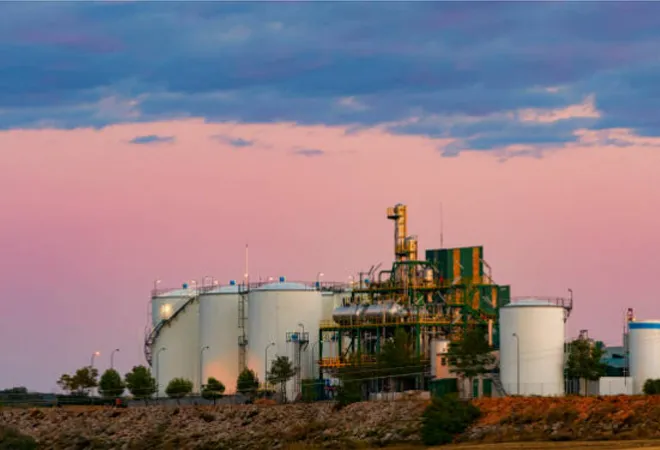
The Glasgow agreement of the recently held 26th UNFCCC Conference of the Parties (COP26) concluded that the world is not doing enough to tackle the climate challenge. It urged the countries to strengthen their 2030 climate commitments or the Nationally Determined Contributions (NDCs). PM Modi, in his address at the COP26, released India’s updated NDCs in the form of five key announcements. The most prominent of these included India’s goal to produce 500 GW of renewable energy by 2030 and its ambitious target to achieve net-zero by 2070.
During the COP26, Union Minister of Science & Technology, Jitendra Singh, launched the mission “Integrated Biorefineries”, a collaborative initiative between India and the Netherlands to develop clean energy solutions under Mission Innovation Initiative. An integrated biorefinery is a facility that transforms biomass into value-added products while recovering as much energy as possible. It has the potential to produce bulk and fine chemicals in a robust, self-sufficient, sustainable, and ecologically friendly manner. Through various domestic and international initiatives in the biofuels industry in the last few years, India has reiterated its inclination to explore bio-solutions as yet another form of renewable energy and alternative to fossil-based fuels.
An integrated biorefinery is a facility that transforms biomass into value-added products while recovering as much energy as possible.
The global energy demand is ever rising, projected to reach a whopping 17 billion tonnes of oil equivalent in the next decade. According to the BP Energy Outlook 2019, India’s share in the global energy demand is expected to reach 11 percent by 2040. As emission-heavy fuels like coal, oil and gasoline contribute to 69 percent of the national energy supply, this whopping demand will naturally bring adverse climate ramifications as well as skewed import dependence. For instance, India’s fuel imports comprised US $104.3 billion out of total imports of US $367.9 billion (28.35 percent share) despite the economic slump in 2020. They also render India’s energy sector sensitive to geopolitical instability and supply chain disruptions. Amidst the anthropogenic climate threat posed by greenhouse gas emissions from fossil-based fuels and the looming fear of depleting fossil reserves, biofuels promise to be an alternative with many advantages.
Biofuels as a Sustainable Energy System
Biofuels provide a sustainable energy system that is renewable, environmentally friendly and capable of utilising indigenous raw materials. The most commonly employed method for biofuel production involves fermentation, a process in which microbes convert simple sugars such as glucose to value-added chemicals by various biochemical pathways. Biofuel production can be carried out at mild temperatures between 25-45℃ in contrast to chemical methods (requiring >500℃), which makes the entire process energy efficient. In comparison to fossil fuel-derived energy, biofuels project scope not only in reduction of carbon emissions but also ensure self-sufficiency of the raw materials.
Essentially the fermentation is of two kinds: Solid-state and submerged fermentation. Among these, solid-state fermentation that allows the cultivation of microorganisms in absence of water, is 100 times more economically efficient than submerged fermentation, for water is one of the major cost attributing factors. Since it is tougher to optimise and engineer, submerged fermentation remains a popular choice among researchers. Keeping in mind the water sustainability, and economic advantages, utilising solid-state fermentation needs to be considered.
As emission-heavy fuels like coal, oil and gasoline contribute to 69 percent of the national energy supply, this whopping demand will naturally bring adverse climate ramifications as well as skewed import dependence.
Despite the above-mentioned advantages, microbial fermentation for biofuel production faces a lot of challenges. In general, the process cost is very high in comparison to commercial fuels. A major fraction of this cost is owed to expensive substrates such as glucose. To reduce the biofuel cost, it becomes imperative to look out and work on cheaper feedstocks. Based on the feedstocks used, biofuels are categorised into four generations, each emerging to overcome the limitations of the previous one. The first generation uses food crops such as corn, sugarcane etc while the second generation is based on utilisation of lignocellulosic agro-residues such as rice bran, wheat bran etc. While the first one leads to the ethical debate of food vs fuel, second-generation feedstocks are in plenty and generally considered a waste. Additionally, food waste from restaurants, kitchens, or supply chain slacks is a good source of sugar. Referred to as Municipal Solid Waste (MSW), food waste is a nuisance to the environment and public health. India has a huge capacity to produce these feedstocks, generating >300 million tonnes of agricultural waste every year and nearly 0.3 billion tonnes of food waste every year. They are potential substrates for biofuel production due to their indigenous abundance, cost-effectiveness and high sugar content. Additionally, utilisation of such raw materials also enables a circular economy.
Another challenge faced by researchers is the low efficiency of this fermentative production. To compete with market demands, high yields from a low substrate is desirable. However, utilising agricultural and food wastes means additional steps of pre-treatment for breaking layers of cellulose, hemicellulose and chitin respectively before carbohydrates can be recovered. This often results in multi-step processing, making the process tedious, expensive and inefficient. To improve the yield and process efficiency biotechnological tools such as genetic engineering and process engineering are being applied.
India & the Biofuels: Recent Policy Initiatives
The Indian government has recognised this capacity of indigenous feedstocks for biofuel production. For instance, the National Policy on Biofuels 2018 acknowledges the ‘strategic role of biofuels in the Indian Energy Basket’. The policies are centred around increasing the production of bioethanol using sugar-containing (sugar beet, sweet sorghum etc.) and starch-containing materials (corn, damaged food grain, etc.) that are unfit for human consumption. Recognising the lack of capital in this sector, the government has mobilised a viability funding gap scheme worth INR 5000 crore for second-generation ethanol biorefineries. India also targets a 20 percent ethanol-blending in petrol by 2023-24.
The first generation uses food crops such as corn, sugarcane etc while the second generation is based on utilisation of lignocellulosic agro-residues such as rice bran, wheat bran etc.
Even before the recent COP26 announcements, India has sought to establish itself in the biofuels sector through international mechanisms in recent years. In the backdrop of PM Modi’s visit to the United States in September 2021, India and the US formed a bilateral India-US New Task Force on Biofuels, which will promote technology transfers and develop business models to develop the biofuels sector. In December 2020, the Asian Development Bank approved a US $2.4 million grant under Asian Clean Energy Fund for supporting biofuels development in India. India also has an MoU with Brazil on Bioenergy Cooperation, which holds an excellent track record of harnessing sugarcane feedstock for biofuels.
Biofuels for ‘Atma Nirbharta’
Albeit biofuels may not fulfil India’s major share of energy demand, they will be crucial in serving India’s strategic goals of self-reliance (Atmanirbharta) over the decadal horizon. Firstly, biofuels will reduce dependence on fuel imports that save foreign reserves and will plug the capital outflow. According to NITI Aayog’s Expert Committee, fulfilling the 2025 targets for 20 percent ethanol blending (E20) will save US $4 billion in forex reserves annually. Secondly, they will also address the supply chain vulnerabilities of a fossil-fuel-based energy system. As India’s mammoth agricultural waste is generated in the countryside, setting up biofuel manufacturing plants will create localised supply chains. These local supply chains need to be efficient to account for the perishability of feedstock due to pest contamination and weather. It will cut down the logistics and transportation costs of non-renewable energy and insulate the supply chains from geopolitical instability and global economic shocks. Thirdly, the biofuel sector would generate semi-skilled employment in rural areas and create additional incomes for Indian farmers. For example, sugar mills may earn an additional profit of US $2 billion in 2020-21 owing to the ethanol industry. Increasing the purchasing power of rural India would drive consumer demand, which would have a multiplier effect on India’s informal economy.
As India’s mammoth agricultural waste is generated in the countryside, setting up biofuel manufacturing plants will create localised supply chains. These local supply chains need to be efficient to account for the perishability of feedstock due to pest contamination and weather.
However, there are a few caveats. To advance towards E20 targets, the government has been promoting food crops over second-generation feedstock lately. This demands an abrupt increase in the production of coarse grains like maize, barley, millet etc. in the medium term. These developments indicate that as demand for feedstock rises, policymakers should also consider disruption in agriculture patterns. Profits in the food market must remain as competitive as that of feedstock, or else farmers will respond by growing high-sugar content yielding crops irrespective of food demand, soil health, and environmental concerns. It will lead to indirect land-use change (iLUC) and, thus, a rise in net emissions. Further, second-generation agro-wastes are widely used as poultry feed. A shift in using that as feedstock will create ripples in the poultry sector, straining the food supply. Therefore, the incentives provided for cultivating more feedstock-generating crops should account for the country's food security.
Biofuel production for self-reliance can become a reality by incentivising and educating the local suppliers and waste segregation about the wealth-creating potential of their waste. India needs to promote greater engagements between science, industry and society to meet this goal.
The views expressed above belong to the author(s). ORF research and analyses now available on Telegram! Click here to access our curated content — blogs, longforms and interviews.




 PREV
PREV



